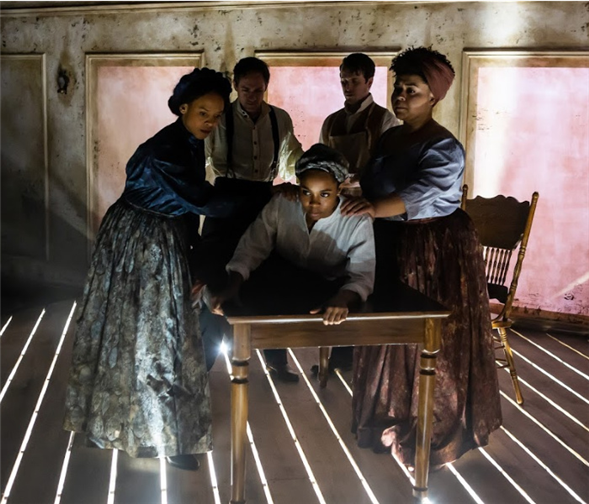Translate Page

A new play examines the complicated legacy of Dr. J. Marion Sims
---
Naomi Lorrain always hears groans from the audience when her character, Philomena, undergoes a gynecological examination in Behind the Sheet, a new drama at Ensemble Studio Theatre. "I can hear them exhale and go 'ugh' -- especially a lot of the women," she says. "They cross their legs and have a visceral response. They know the pain that can come with some of the problems that can happen when you're a woman."
Of course there's an added layer of discomfort because Philomena is a slave in 1840s Alabama serving as guinea pig for her doctor, George, who also happens to be her owner.
Playwright Charly Evon Simpson -- who was "obsessed" with TLC birthing shows as a child and even considered becoming an ob-gyn -- was inspired to pen Behind the Sheet after reading a Gawker article about Dr. J. Marion Sims. Frequently called "the father of modern gynecology," he invented the speculum, founded the first women's hospital in the U.S. and pioneered the treatment of fistulas, holes between the vagina and rectum or bladder that occur during childbirth and cause agony and incontinence. However, these medical breakthroughs came at a terrible cost: He experimented on slaves, reportedly without anesthesia. "I was really surprised by all that," Simpson says. "And saddened, of course, that this group of women had to endure what they did in order for fistulas to be solved."
That history informs Behind the Sheet, Simpson's fictionalized take on Sims' story, which explores the ongoing ethical dilemma of his work. "We all benefit from his efforts, but it was at the expense of these women, these slaves, who couldn't give consent," says Lorrain, who earned her B.A. in the History of Science, History of Medicine and African American Studies from Yale University before segueing to acting. "I'm so happy to be part of this show so the general public can learn how black female bodies were used to advance the field of gynecology."
Sims operated on at least 11 slaves with fistulas who lived on his plantation, though only three are named in the historical record: Anarcha, Betsey and Lucy. Because they were not given anesthesia, the women had to hold each other down during operations. But Simpson didn't want Behind the Sheet to be just another play about black slaves in turmoil; she also wanted to celebrate their camaraderie, even under such awful circumstances.
"I find myself walking this line: Wanting to acknowledge black suffering and, on the flip side, highlighting that we can find joy despite the pain," Simpson says. As such, Behind the Sheet celebrates the bond among these enslaved women who find ways to help each other heal. "When I think about my ancestors, I wonder, did they survive because they found each other?" Simpson says. "I don't know if that was true, but for me that was important."
Although Sims' lauded reputation has been challenged in recent years -- in 2018 the city removed a statue of him from Central Park after public outcry -- some of his ignorant notions about black women and pain persist today. Recent studies show that white doctors often undertreat African Americans for pain, and black women are more likely to die from pregnancy-related causes than their white peers.
Simpson hopes African-American women who see her play will learn to trust their bodies and self-advocate. "The history of gynecology was about ignoring the fact that we feel pain," she says. "It's important to be able to speak up and not let someone who is not experiencing our pain say we don't need a certain thing."
Meanwhile, Lorrain wants audiences to question the history they've been taught, where white men are often given "all of the credit" for historical achievements. "There were people involved in these scientific discoveries from ostracized communities," she says. "They were also at the helm of this. I hope people leave knowing the nameless were as important as the named."
To read about a student's experience at Behind the Sheet, check out this post on TDF's sister site SEEN.
---
Follow Diep Tran at @DiepThought. Follow TDF at @TDFNYC.
Top image: Nia Calloway, Joel Ripka, Naomi Lorrain, Stephen James Anthony and Cristina Pitter in Behind the Sheet. Photos by Jeremy Daniel.
TDF MEMBERS: Browse our discount tickets to theatre, dance and concerts.